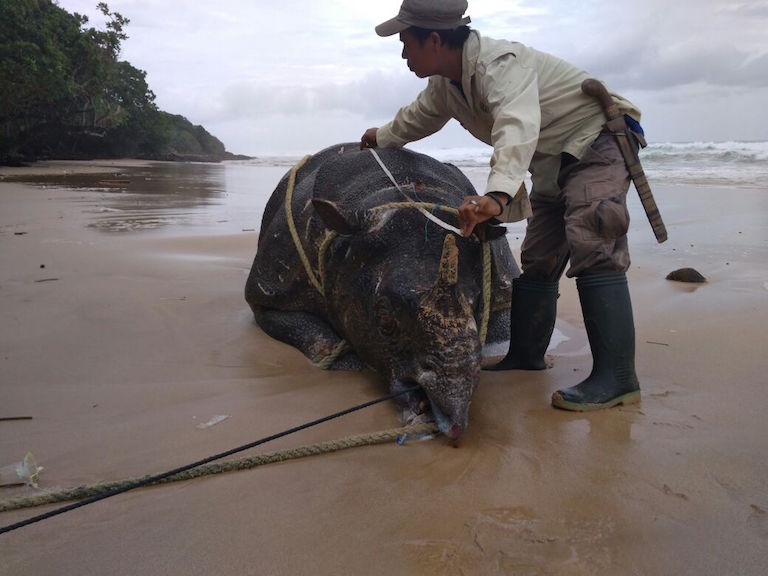- Last month, rangers in Indonesia’s Ujung Kulon National Park found an adult male rhino dead on a beach.
- A necropsy determined the rhino’s death was due to complications from a twisted bowel, putting to rest fears of poaching or contagion.
- Despite the death, the Javan rhino population has shown stable growth with the birth of two calves earlier this year, putting the tally at minimum 68 individuals.
JAKARTA — Veterinarians and wildlife experts in Indonesia have determined the death of a rhinoceros in the west coast of Java Island last week was due to fatal complications from a twisted intestine. The announcement puts to rest fears the animal could have been killed by poachers or an infectious disease.
Rangers at Ujung Kulon National Park, home to the only remaining population of the critically endangered Javan rhino (Rhinoceros sondaicus), on April 23 found an adult male rhino dead on one of the park’s beaches. The animal was thought to be 30 years old and was affectionately known as Samson. His death brought the total known population of the species to 68 individuals.
None of the rhino’s body parts were missing, indicating that poaching was not the cause of death, and a preliminary examination showed no signs of poisoning or contagious infection. The park’s officials then took tissue samples to make a conclusive report on the cause of the death.

The necropsy found that the rhino’s large and small intestines were twisted, eventually releasing bacterial toxins that spread throughout the body, according to a team of veterinarians from Bogor Agricultural University (IPB) and WWF-Indonesia.
This condition is not new to the species. A 2012 paper by a veterinarian at IPB found that the intestinal condition had killed five Javan rhinos in 1982 and one in 2003.
“The most important thing is that the death was not because of rhino poaching, as the horn is still attached,” said Kurnia Khairani, a veterinarian with WWF, in an April 27 statement. “The necropsy result also indicates that [the death] was not from infection or contagious diseases, like anthrax.”
Experts had feared the possibility of an epidemic. With the entire species confined to a single nature reserve, a contagious disease could potentially wipe out the Javan rhino for good.
Although the death was attributed to natural causes, it adds urgency to calls for a portion of the population to be relocated to a second site.
The Indonesian government and rhino experts have since 2015 been scouting for such a site, to avoid a decline in population due to the park reaching carrying capacity and to serve as insurance against the threats of diseases, poaching and other human incursions, and natural disasters such as tsunamis and volcanic eruptions.
Despite the death of Samson, the Javan rhino population has expanded with the birth of two calves earlier this year, putting the tally at minimum 68 individuals: 29 adult males, 24 adult females and 15 juveniles.

Banner image: A park ranger examines the male Javan rhino found dead on April 23. Image courtesy of the Ujung Kulon National Park Agency.
FEEDBACK: Use this form to send a message to the author of this post. If you want to post a public comment, you can do that at the bottom of the page.
